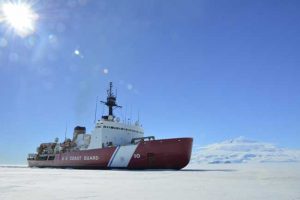 |
MCMURDO STATION, Antarctica – The crew of U.S. Coast Guard Cutter Polar Star completed their mission Tuesday in support of National Science Foundation (NSF) after cutting a resupply channel through 15 miles of Antarctic ice in the Ross Sea and escorting supply vessels to the continent.
The Polar Star sailed from Seattle to assist in the annual delivery of operating supplies and fuel for NSF research stations in Antarctica during Operation Deep Freeze by carving a navigable path through seasonal and multi-year ice sometimes as much as 10-feet thick. Operation Deep Freeze is the logistical support provided by the U.S. Armed Forces to the U.S. Antarctic Program.
“Although we had less ice this year than last year, we had several engineering challenges to overcome to get to the point where we could position ourselves to moor in McMurdo,” said Capt. Michael Davanzo, the commanding officer of the Polar Star. “Our arrival was delayed due to these challenges, but the crew and I are certainly excited to be here. It’s a unique opportunity for our crewmembers to visit the most remote continent in the world, and in many respects it makes the hard work worth it.”
On Jan. 16, Polar Star’s shaft seal failed causing flooding in the cutter’s engine room at a rate of approximately 20-gallons per minute. The crew responded quickly, using an emergency shaft seal to stop the flow of freezing, Antarctic water into the vessel. The crew was able dewater the engineering space and effect more permanent repairs to the seal to ensure the watertight integrity of the vessel. There were no injuries as a result of the malfunction.
Flooding was not the only engineering challenge the crew of Polar Star faced during their trek through the thick ice. On Jan. 11, their progress was slowed after the one of the cutter’s three main gas turbines failed. The crew uses the cutter’s main gas turbine power to breakup thick multi-year ice using its propellers. The crew was able to troubleshoot the turbine finding a programing issue between the engine and the cutter’s 1970s-era electrical system. The crew was able to continue their mission in the current ice conditions without the turbine.[xyz-ihs snippet=”adsense-body-ad”]“If the Polar Star were to suffer a catastrophic mechanical failure, the Nation would not be able to support heavy icebreaker missions like Operation Deep Freeze, and our Nation has no vessel capable of rescuing the crew if the icebreakers were to fail in the ice,” said Vice Adm. Fred Midgette, commander, U.S. Coast Guard Pacific Area in Alameda, California. “The crewmembers aboard Polar Star not only accomplished their mission, but they did so despite extreme weather and numerous engineering challenges. This is a testament to their dedication and devotion to duty.”
The cutter refueled at McMurdo Station Jan. 18 and continued to develop and maintain the ice channel in preparation for two resupply ships from U.S. Military Sealift Command, Ocean Giant and Maersk Peary. The crew of Polar Star escorted the vessels to the ice pier at McMurdo Station, an evolution that requires the cutter to travel about 300 yards in front of the supply ships to ensure they safely make it through the narrow ice channel. The crew escorted the Ocean Giant to the ice pier at McMurdo Jan. 27 and conducted their final escort of the Maersk Peary to Antarctica Feb. 2. The crew escorted Maersk Peary safely out of the ice Feb. 6 after supply vessel’s crew transferred their cargo.
Crewmembers aboard the Coast Guard Cutter Polar Star break ice as the cutter transits through McMurdo Sound near Antarctica on Monday, Jan. 8, 2018. U.S. Coast Guard footage by Chief Petty Officer Nick Ameen.
The Polar Star departed their homeport in Seattle Nov. 30, 2017, and are expected to return to the U.S. in March 2018. The 399-foot Polar Star is the only operational heavy icebreaker in the U.S. fleet. The cutter, which was built more than 40 years ago, has a crew of nearly 150 people. It weighs 13,500 tons and uses 75,000 horsepower to break ice up to 21 feet thick.
The U.S. military is uniquely equipped to assist the National Science Foundation in accomplishing its USAP mission. This includes the coordination of strategic inter-theater airlift, tactical intra-theater airlift and airdrop, aeromedical evacuation support, search and rescue response, sealift, seaport access, bulk fuel supply, port cargo handling, and transportation requirements supporting the NSF, the lead agency for the USAP.
Source: USCG
